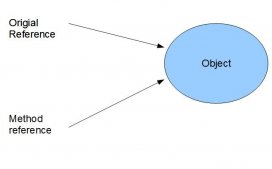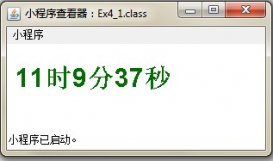在Java编程中,有些知识并不能仅通过语言规范或者标准API文档就能学到的,本文为大家罗列。
一、实现
1、现equals()
|
1
2
3
4
5
6
7
8
9
10
11
12
13
14
15
16
17
18
19
20
21
22
23
24
25
26
27
28
29
30
31
32
33
|
class Person { String name; int birthYear; byte[] raw; public boolean equals(Object obj) { if (!obj instanceof Person) return false; Person other = (Person)obj; return name.equals(other.name) && birthYear == other.birthYear && Arrays.equals(raw, other.raw); } public int hashCode() { ... }} |
- 参数必须是Object类型,不能是外围类。
- foo.equals(null) 必须返回false,不能抛NullPointerException。(注意,null instanceof 任意类 总是返回false,因此上面的代码可以运行。)
- 基本类型域(比如,int)的比较使用 == ,基本类型数组域的比较使用Arrays.equals()。
- 覆盖equals()时,记得要相应地覆盖 hashCode(),与 equals() 保持一致。
2、现hashCode()
|
1
2
3
4
5
6
7
8
9
10
11
12
13
14
15
16
17
18
19
20
21
22
23
|
class Person { String a; Object b; byte c; int[] d; public int hashCode() { return a.hashCode() + b.hashCode() + c + Arrays.hashCode(d); } public boolean equals(Object o) { ... }} |
- 当x和y两个对象具有x.equals(y) == true ,你必须要确保x.hashCode() == y.hashCode()。
- 根据逆反命题,如果x.hashCode() != y.hashCode(),那么x.equals(y) == false 必定成立。
- 你不需要保证,当x.equals(y) == false时,x.hashCode() != y.hashCode()。但是,如果你可以尽可能地使它成立的话,这会提高哈希表的性能。
- hashCode()最简单的合法实现就是简单地return 0;虽然这个实现是正确的,但是这会导致HashMap这些数据结构运行得很慢。
3、实现compareTo()
|
1
2
3
4
5
6
7
8
9
10
11
12
13
14
15
16
17
18
19
20
21
22
23
24
25
26
27
28
29
30
31
32
33
34
35
36
37
|
class Person implements Comparable<Person> { String firstName; String lastName; int birthdate; // Compare by firstName, break ties by lastName, finally break ties by birthdate public int compareTo(Person other) { if (firstName.compareTo(other.firstName) != 0) return firstName.compareTo(other.firstName); else if (lastName.compareTo(other.lastName) != 0) return lastName.compareTo(other.lastName); else if (birthdate < other.birthdate) return -1; else if (birthdate > other.birthdate) return 1; else return 0; }} |
总是实现泛型版本 Comparable 而不是实现原始类型 Comparable 。因为这样可以节省代码量和减少不必要的麻烦。
只关心返回结果的正负号(负/零/正),它们的大小不重要。
Comparator.compare()的实现与这个类似。
4、实现clone()
|
1
2
3
4
5
6
7
8
9
10
11
12
13
14
15
16
17
18
19
20
21
22
23
24
25
26
27
28
29
30
31
32
33
|
class Values implements Cloneable { String abc; double foo; int[] bars; Date hired; public Values clone() { try { Values result = (Values)super.clone(); result.bars = result.bars.clone(); result.hired = result.hired.clone(); return result; } catch (CloneNotSupportedException e) { // Impossible throw new AssertionError(e); } }} |
- 使用 super.clone() 让Object类负责创建新的对象。
- 基本类型域都已经被正确地复制了。同样,我们不需要去克隆String和BigInteger等不可变类型。
- 手动对所有的非基本类型域(对象和数组)进行深度复制(deep copy)。
- 实现了Cloneable的类,clone()方法永远不要抛CloneNotSupportedException。因此,需要捕获这个异常并忽略它,或者使用不受检异常(unchecked exception)包装它。
- 不使用Object.clone()方法而是手动地实现clone()方法是可以的也是合法的。
二、预防性检测
1、预防性检测(Defensive checking)数值
|
1
2
3
4
5
6
7
8
9
10
11
12
13
14
15
16
17
18
19
|
int factorial(int n) { if (n < 0) throw new IllegalArgumentException("Undefined"); else if (n >= 13) throw new ArithmeticException("Result overflow"); else if (n == 0) return 1; else return n * factorial(n - 1);} |
- 不要认为输入的数值都是正数、足够小的数等等。要显式地检测这些条件。
- 一个设计良好的函数应该对所有可能性的输入值都能够正确地执行。要确保所有的情况都考虑到了并且不会产生错误的输出(比如溢出)。
2、预防性检测对象
|
1
2
3
4
5
6
7
8
9
|
int findIndex(List<String> list, String target) { if (list == null || target == null) throw new NullPointerException(); ...} |
- 不要认为对象参数不会为空(null)。要显式地检测这个条件。
3、预防性检测数组索引
|
1
2
3
4
5
6
7
8
9
10
11
12
13
|
void frob(byte[] b, int index) { if (b == null) throw new NullPointerException(); if (index < 0 || index >= b.length) throw new IndexOutOfBoundsException(); ...} |
不要认为所以给的数组索引不会越界。要显式地检测它。
4、预防性检测数组区间
|
1
2
3
4
5
6
7
8
9
10
11
12
13
14
15
|
void frob(byte[] b, int off, int len) { if (b == null) throw new NullPointerException(); if (off < 0 || off > b.length || len < 0 || b.length - off < len) throw new IndexOutOfBoundsException(); ...} |
不要认为所给的数组区间(比如,从off开始,读取len个元素)是不会越界。要显式地检测它。
三、数组
1、填充数组元素
使用循环:
|
1
2
3
4
5
6
7
8
9
10
11
|
// Fill each element of array 'a' with 123byte[] a = (...);for (int i = 0; i < a.length; i++) a[i] = 123;(优先)使用标准库的方法:Arrays.fill(a, (byte)123); |
2、复制一个范围内的数组元素
使用循环:
|
1
2
3
4
5
6
7
8
9
10
11
12
13
14
15
16
17
|
// Copy 8 elements from array 'a' starting at offset 3// to array 'b' starting at offset 6,// assuming 'a' and 'b' are distinct arraysbyte[] a = (...);byte[] b = (...);for (int i = 0; i < 8; i++) b[6 + i] = a[3 + i];(优先)使用标准库的方法:System.arraycopy(a, 3, b, 6, 8); |
3、调整数组大小
使用循环(扩大规模):
|
1
2
3
4
5
6
7
8
9
10
11
|
// Make array 'a' larger to newLenbyte[] a = (...);byte[] b = new byte[newLen];for (int i = 0; i < a.length; i++) // Goes up to length of A b[i] = a[i];a = b; |
使用循环(减小规模):
|
1
2
3
4
5
6
|
// Make array 'a' smaller to newLenbyte[] a = (...);byte[] b = new byte[newLen];for (int i = 0; i < b.length; i++) // Goes up to length of B b[i] = a[i];a = b; |
(优先)使用标准库的方法:
|
1
|
1a = Arrays.copyOf(a, newLen); |
4、把4个字节包装(packing)成一个int
|
1
2
3
4
5
6
7
8
9
10
11
12
13
14
15
16
17
18
19
20
21
22
23
24
25
|
int packBigEndian(byte[] b) { return (b[0] & 0xFF) << 24 | (b[1] & 0xFF) << 16 | (b[2] & 0xFF) << 8 | (b[3] & 0xFF) << 0;} int packLittleEndian(byte[] b) { return (b[0] & 0xFF) << 0 | (b[1] & 0xFF) << 8 | (b[2] & 0xFF) << 16 | (b[3] & 0xFF) << 24;} |
5、把int分解(Unpacking)成4个字节
|
1
2
3
4
5
6
7
8
9
10
11
12
13
14
15
16
17
18
19
20
21
22
23
24
25
26
27
28
29
30
31
32
33
|
byte[] unpackBigEndian(int x) { return new byte[] { (byte)(x >>> 24), (byte)(x >>> 16), (byte)(x >>> 8), (byte)(x >>> 0) };} byte[] unpackLittleEndian(int x) { return new byte[] { (byte)(x >>> 0), (byte)(x >>> 8), (byte)(x >>> 16), (byte)(x >>> 24) };} |
总是使用无符号右移操作符(>>>)对位进行包装(packing),不要使用算术右移操作符(>>)。
以上就是本文的全部内容,希望对大家的学习有所帮助。














